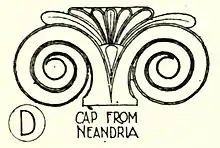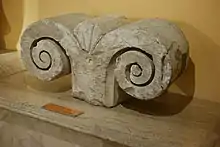Aeolic order
The Aeolic order or Aeolian order was an early order of Classical architecture. It has a strong similarity to the better known Ionic order, but differs in the capital, where a palmette rises between the two outer volutes, rather than them being linked horizontally by a form at the top of the capital. Many examples also show simplified details compared to the Ionic.

.jpg.webp)
Background and history
"Proto-Aeolic" capitals of Southern Levant
"Capitals" that were never used over columns of a style widely known as "Proto-Aeolic" or "Proto-Ionian", are found in city gates and royal buildings in the kingdoms of Israel (mainly from the 9th century BCE), Judah, Moab, and Ammon (late 8th or early 7th century BCE).[1] The more appropriate and neutral name "Iron Age volute capitals from the Levant" has been offered. The connection to the Aeolic order, which they precede, is rather complex and probably based on a general use of palm-tree decoration throughout the Ancient Near East.[2][3][4]
Aeolic order of Asia Minor
The Aeolic form developed in northwestern Asia Minor, out of Syrian and Phoenician capitals. It is also seen in some temples in Sicily,[2] and is named from the Aeolian colonies of northwestern Asia Minor.[5] The earliest surviving examples of the Aeolic order are contemporary with the emergence of the Ionic and Doric orders in the 6th century BC. Some authorities have suggested that the Ionic style represents a development of the Aeolic, but others disagree.[6]

In the 1970s, there were found 34 proto-Aeolic alleged capitals in Israel/Palestine, of which 13 belonged to Megiddo and 7 to the Samaria. They were built up for some ashlar masonries, an architectonic style reserved to the Israelite royal places during the Iron Age. One of them is 110 x 28 x 60 cm of dimension and also differs from the canon for its ornamental details, showing a triangular shape in the centre as the point of juncture of the capital volutes.[7]
Associated forms
Some Etruscan tombs show a similar capital, with two large volutes that do not lie flat, but no palmette in the centre as in the Tomb of the Reliefs.
Timeline
The Aeolic order fell out of use at the end of the Archaic Period.
See also
References
- Franklin, Norma, From_Megiddo_to_Tamassos_and_Back_Putting_the_Proto_Ionic_Capital_in_its_Place
- Shiloh, Yigal (1979). "The Proto-Aeolic Capital and Israelite Ashlar Masonry". Qedem. Institute of Archaeology, Hebrew University of Jerusalem. 11: III–95. JSTOR 43588582. Retrieved 3 September 2020.
- Wiener, Noah (1 May 2014). "Proto-Aeolic Capital Associated with Judah's Longest Spring Tunnel: Investigating royal iconography and large-scale construction in Iron Age Judah". Biblical Archaeology Society. Retrieved 1 December 2014.
- Lipschits, Oded. The Origin and Date of the Volute Capitals from the Levant, in: Finkelstein, Israel and Na'aman, Nadav (eds). The Fire Signals of Lachish. Eisenbrauns (Winona Lake, 2011), pp. 203-225. Accessed 4 September 2020.
- Philip P. Betancourt. The Aeolic Style in Architecture: A Survey of its Development in Palestine, the Halikarnassos Peninsula, and Greece, 1000-500 B.C (Princeton University Press) 1977.
- The Art and Culture of Early Greece, 1100-480 B.C., p. 132, Cornell University Press, 1987 (rev. edn.), ISBN 9780801494017
- Y. Shilow - Hebrew University of Jerusalem (April 1, 1976). "New Proto-Aeolic Capitals Found in Israel". Bulletin of the American Schools of Oriental Research. 222 (1): 67–77. doi:10.2307/1356300. ISSN 0003-097X. JSTOR 1356300. OCLC 7931001310. S2CID 163470552. Retrieved September 15, 2020.
External links
Aeolic order
- Jenkins, Ian (2006). Greek Architecture and Its Sculpture. Harvard University Press. p. 19. ISBN 9780674023888. Retrieved 3 August 2020.
- Ionic order, Foundation of the Hellenic World. Aeolic order in relation to Ionic and Doric orders, image. Accessed September 2020.
- Just a Second: Aeolic Order, The Art Minute: Short Lessons in Art History. Accessed September 2020.
- Aeolic Capital, Oxford Reference. Accessed September 2020.
- Aeolic capital, The Oxford Companion to Architecture. Accessed September 2020.
- Aeolic Order, Archaeologs project. Accessed September 2020.
- Architectural Orders, Classical Art Research Centre. Accessed September 2020.
- Aeolic-capital, Encyclopædia Britannica. Accessed September 2020.
Proto-Aeolic capital
- Proto-Aeolic Capital, Ancient History Encyclopedia Foundation. Accessed September 2020.
- Ein Mor, Daniel. Walajeh ('Ain Joweizeh): Preliminary Report, Hadashot Arkheologiyot, Volume 125, Year 2013 (16/06/2013). Proto-Aeolic capital in context: the opening of a water system (tunnel spring) façade. Accessed September 2020.
- At popular Jerusalem promenade, archaeologists find a First Temple-era palace, Times of Israel, posted and accessed 3 September 2020. Latest finds of numerous Proto-Aeolic capitals.